Wallis und Futuna |
|
|
|
| Übersicht – Contents: | |
Wallis und Futuna |
|
|
|
| Übersicht – Contents: | |
Flagge – Flag: |
|
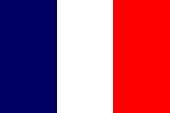 |
die Flagge Frankreichs |
| inoffizielle Flagge – unofficial Flag: | |
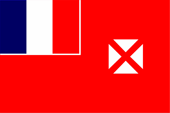 |
seit /since 1985,    |
| Die Königreiche von Wallis und Futuna – The Kingdoms of Wallis and Futuna: | |
| Alo | |
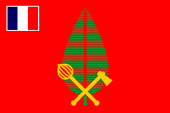 |
Flagge des Königreichs Alo |
| Sigave | |
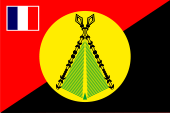 |
Flagge des Königreichs Sigave |
| Uvea | |
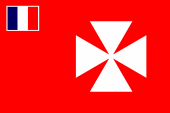 |
seit /since 1985, |
| Alle französischen Kolonien, hatten über lange Zeit keine eigene Flagge. Es musste die französische Trikolore gehisst werden. Das gilt im Prinzip bis heute. Der Status der Kolonien änderte sich über die Jahre. Einige sind heute Überseedepartements, und damit ein ultraperipherischer Teil Frankreichs und auch der EU; andere sind Überseegemeinschaften, die autonom sind, und nicht Teil Frankreichs oder der EU. Überseedepartements gehören – nicht wie die Departements des Mutterlandes – zu keiner administrativen Region Frankreichs, sondern bilden eine eigene Region. |
All French colonies had no own flag over a long period. It had to be hoisted
the French tricolor. This in principle usual until today.
The status of the colonies changed over the years. Some of them are now overseas departments, and thus a ultraperipheric part of France and of the EU; others are overseas communities, autonomous, and not a part of France or the EU. Overseas departments belong – in contrast to the departments of the motherland – to no administrative region of France, they are a separate region. |
| Die Gebietskörperschaft muss demzufolge offiziell die Flagge Frankreichs verwenden, jedoch können der Generalrat als oberstes gewähltes Kollegialorgan eines französischen Départements und auch der Regionalrat als oberstes gewähltes Kollegialorgan einer französischen Region eigene Flaggen haben. | The territorial entity has therefore officially to use the flag of France. However, the General Council as the highest elected collegial body of a French Department and the Regional Council as the highest elected collegial body of a French Region can have their own flags. |
| Diese Départements- und Regionsflaggen haben allerdings oft das Erscheinungsbild von Firmenflaggen mit Logos oder gar stilisierten Bildern, wirken lieblos, unhistorisch, technokratisch und modernistisch, denn im streng zentralistischen Frankreich wird jedwede Regionalität oder gar ein Bezug zur Geschichte vermieden. Darum sind diese Regions-Logo-Flaggen unbeliebt und werden kaum benutzt. | These flags of departments and regions, however, have oftenly the appearance of company flags with logos or even stylized images, appear carelessly, ahistorical, technocratic and modernist, because in the strictly centralist France is avoided any regionalism or even a historical subscription. Because of that these logo flags of regions are unpopular and are rarely used. |
| Auf Wallis und Futuna gibt es für lokale Zwecke eine inoffizielle Flagge, die neben der Flagge Frankreichs gehisst weden darf. Sie wurde der Gestaltung des Wappens nachempfunden und ist rot mit der französischen Trikolore in der Oberecke und trägt im fliegenden Ende ein weißes stilisiertes Kreuz, das aus vier Dreiecken gebildet wird. Diese stehen für die drei Königreiche auf den Inseln und die französische Verwaltung. Die drei Königreiche Alo, Sigave und Uvea haben jedes seine eigene Flagge, die als gemeinsames Merkmal die französische Flagge in der Oberecke zeigen. |
In Wallis and Futuna exists for local purposes an unofficial flag, for which
it is allowed to hoist it next to the flag of France. It was modeled on the design of the coat of arms and it is red with the French tricolor in the upper corner and in the flying end is placed a white stylized cross, which is made up of four triangles. These stand for the three kingdoms on the islands and the French administration. The three Kingdoms Alo, Sigave and Uvea have each its own flag, which show as a common feature the flag of France in the upper corner. |
| Quelle/Source: Flags of the World | |
| Wappen – Coat of arms: | |
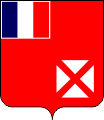 |
Wappen von Wallis und Futuna – coat of arms of Wallis and Futuna, Quelle/Source, nach/by: Wikipedia (DE) |
| Das Wappen von Wallis und Futuna zeigt einen roten Schild mit der französischen Trikolore in der Oberecke und ein weißes stilisiertes Kreuz seitlich im Schildfuß, das aus vier Dreiecken gebildet wird. Diese stehen für die drei Königreiche auf den Inseln und die französische Verwaltung. | The coat of arms of Wallis and Futuna shows a red shield with the French tricolor in the upper corner and a white,sideways moved, stylized cross in the lower part of the shield, which is formed of four triangles. These stand for the three kingdoms on the islands and the French administration. |
| Quelle/Source: Wikipedia (DE) | |
| Landkarten – Maps: |
Lage – Position: |
Landkarte des Landes – Map of the Country: |
|
|
| Zahlen und Fakten – Numbers and Facts: | |
|
|
|
|
|
|
|
|
|
|
|
|
|
|
|
|
| Quelle/Source: Wikipedia (DE) | |
|
1616 · die niederländischen Seefahrer Jacob Le Maire und
Willem Cornelisz Schouten entdecken die Inseln Futuna und Alofi, die von
ihnen "Horn-Inseln" genannt werden
1767 · der englische Seefahrer Samuel Wallis entdeckt die nach ihm benannten Wallis-Inseln 1768 · die Inselgruppe der Horn-Inseln wird vom französischen Seefahrer Louis Antoine de Bougainville wiederentdeckt, er nennt sie "Futuna" 1888 · Schaffung des vereinigten Protektorats der Inseln Wallis und Futuna 1961 · Wallis und Futuna wird Übersee-Territorium ("territoire d’outre-mer") 2003 · Verfassungsänderung in Frankreich, Wallis und Futuna wird "collectivité d’outre-mer" |
|
1616 ·
The Dutch seafarers Jacob Le Maire and Willem Schouten discover the islands
Futuna and Alofi, which are called by them "Hoorn Islands" 1767 · the English seafarer Samuel Wallis discovers the after him called Wallis Islands 1768 · the archipelago of the Horn Islands is rediscovered by the French seafarer Louis Antoine de Bougainville, he calls them "Futuna" 1888 · creation of the united protectorates of Wallis and Futuna Islands 1961 · Wallis and Futuna is overseas territory ("territoire d'outre-mer") 2003 · constitutional amendment in France, Wallis and Futuna is "collectivité d’outre-mer" |
| Quelle/Source: Wikipedia (DE) |
| Die Wallis-Inseln wurden 1767 von dem Engländer Wallis entdeckt, und bekamen seinen Namen. Die Futuna-Inseln wurden 1616 durch die niederländischen Seefahrer Jacob Le Maire und Willem Cornelisz Schouten entdeckt, die sie "Horn-Inseln" nannten. Danach gerieten sie Inseln in Vergessenheit und wurden erst 1768 von dem französischen Seefahrer Louis Antoine de Bougainville wiederentdeckt, der sie "Futuna" nennt, und zwar exakt: "Futuna – das verlorene Kind des Pazifik". | The
Wallis Islands were discovered in 1767 by the Englishman Wallis, and they
got its name. The Futuna Islands were discovered in 1616 by the Dutch navigators Jacob Le Maire and Willem Schouten, who called them "Hoorn Islands". Then they fell into oblivion and the islands were rediscovered in 1768 by the French navigator Louis Antoine de Bougainville, who calls them "Futuna", exactly: "Futuna - the lost child of the Pacific". |
| Quelle/Source: Wikipedia (DE) | |